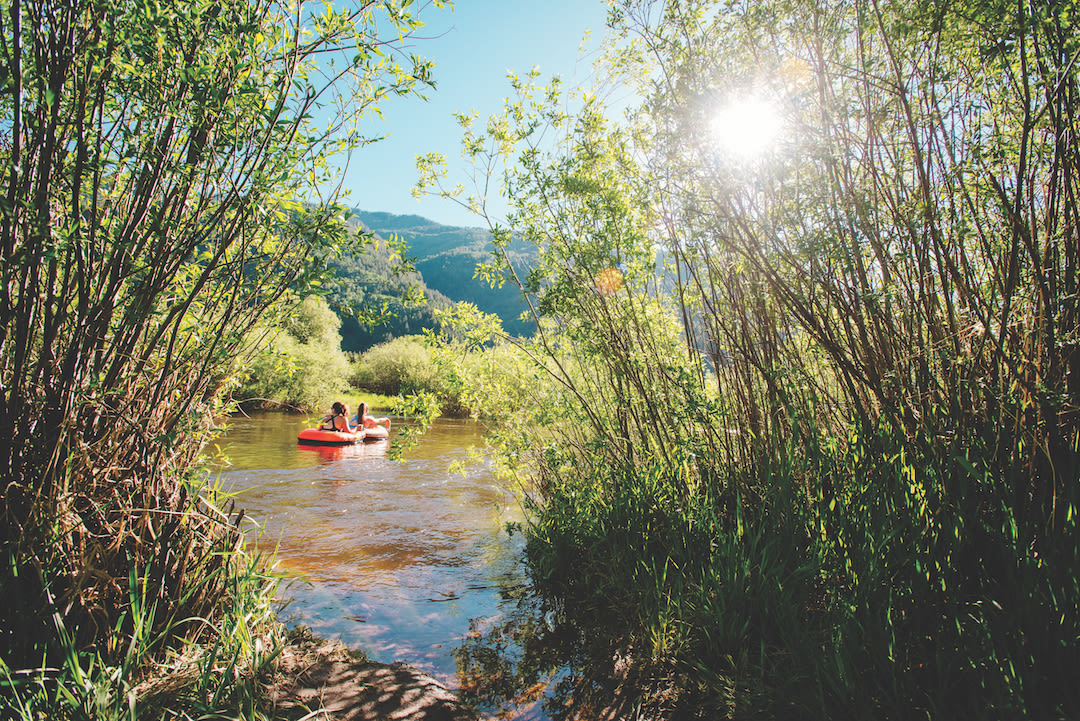Preserving the Peace at North Star Nature Preserve

Floating through Stillwater stretch of the Roaring Fork River.
Image: Ryan Dearth
As you float the sinuous waters of the North Star Nature Preserve, meandering through a lush riparian ecosystem rich in wildlife and scenic beauty, it’s almost impossible to picture development on its wetlands and meadows—let alone 1,500 houses plus commercial buildings.
Yet that could have been the fate of Aspen’s east corridor if former Pitkin County commissioners Dwight Shellman and Joe Edwards hadn’t lowered the allowable zoned density on James H. Smith’s North Star Ranch some 40 years ago. The Nature Conservancy took title of 175 acres of the ranch in 1977 and transferred them to Pitkin County the next year. Instead of accommodating new development, the area became an idyllic refuge.
Recently, however, there’s been a disturbance in paradise. Edwards and his colleagues had envisioned recreational use being limited to hiking, in order to retain the area’s balance as an undisturbed spot for wildlife. Today, however, with the rise of river recreation, North Star sees upward of 100 stand-up paddleboarders, kayakers, and tubers floating the preserve’s stretch of the Roaring Fork River on busy summer days—at the same time that a resident great blue heron colony is in decline. Though the rules haven’t changed since an updated management plan was approved last year, the increased use has spurred a new outreach program to shift public perception about the area through education and improved user management..
“Forty years ago, I don’t recall we ever considered that it could become a place for intensive float trips,” says Edwards, who first gained renown as the Hunter S. Thompson–backed candidate in Aspen’s 1969 mayoral race.
Aspen High School science teacher Andre Wille lives in a cabin that his family has owned since the early 1970s on the banks of Stillwater, the placid section of river that sees the most use. His stories of people disrespecting his private property range from unleashed dogs chasing his chickens to abandoned watercraft littering his lawn. Wille even rescued a girl who had capsized in high water last year. He himself is on the river twice a week and, like many of his neighbors, regularly picks up trash along the way.
“A lot of new people to the valley or who might be here for the summer don’t know the area’s history and its purpose,” says Wille. “Landowners dedicated the area as a nature preserve because it’s invaluable ecologically. A large number of users are going through without concern for the wildlife and natural setting.”
North Star sees upward of 100 stand-up paddleboarders, kayakers, and tubers floating the preserve's stretch of the Roaring Fork River on busy summer days.
The goal of the new outreach program is for users to gain appreciation of and respect for one of Aspen’s sacred resources, which encompasses 10 distinct vegetational communities and more than 140 species, including a potentially endangered toad and one of the highest-altitude blue heron colonies in the state. In 2015, Pitkin County Open Space and Trails partnered with the City of Aspen’s parks department, Aspen Valley Land Trust, the county’s Healthy Rivers and Streams Board, and the Aspen Center for Environmental Studies (ACES) to create a comprehensive management plan for the area (which includes the adjacent 70-acre James H. Smith North Star Open Space). Through extensive ongoing collaboration, this summer’s outreach includes updated signage that spells out rules and regulations, a dedicated informational website (northstaraspen.com), and educational materials distributed at local shops and hotels. Naturalists from ACES are on-site daily through early September to walk the trails and answer visitors’ questions, and ACES also offers several guided hikes in areas of the preserve otherwise closed to the public.
The outreach also includes increased enforcement, with a new “forest protection” officer (under the auspices of the Forest Service, though funded by other entities) at the Wildwood Lane access point, where most of the parking offenses take place.
“The biggest concern is the takeout, where everything happens in a restricted space,” says Pitkin County Open Space and Trails senior ranger John Armstrong. “You’ve got a state highway on a curve with a pedestrian bridge, a bike trail, and the pickup/dropoff area for paddleboards, kayakers, and tubers. We are really concerned about safety.”
Next year, users will notice changes to parking areas and loading zones, as Pitkin County works out logistics with the Colorado Department of Transportation. But in the meantime, the new campaign advises users to park at South Gate, an underutilized parking lot downstream from the overcrowded Wildwood put-in, and to shuttle with bikes instead of vehicles.
Edwards suggests that the county may need to consider adopting rules requiring a permit to float through the preserve and limiting the size and frequency of float trips. For his part, Armstrong hopes it won’t come to that. Despite the heavy use, he says, the area perseveres.
“The resource itself seems very healthy,” he asserts. “The resource we’re trying to protect is quality of experience.”













































